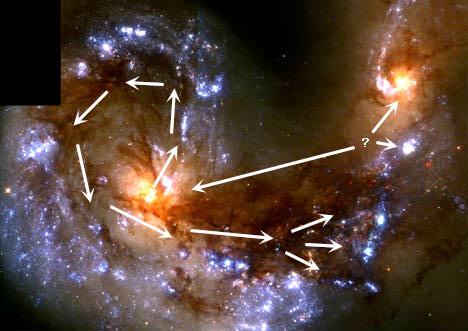Graphic of M82
This is an example of a galaxy where the core recently exploded. Imagine what it would be like to observe a galactic core exploding. The Ball-of-Light Particle Model predicts Quasars are exploding galactic cores.
Sometimes, galactic cores go through temporary but massive instabilities -- perhaps started by a large object impacting the core. When such instabilities occur, the core can eject jets or blobs of material.
Examples
Sometimes, a galactic core will undergo a split decay mode. When this occurs, the single galaxy can split into two or more smaller galaxies. The most dramatic case of this is the Antennae Galaxy.

Note how the two halves of the original galaxy have opposite spins. This is a critical detail. The angular momentum of the two spirals should be equal and opposite if a single core split into two halves.
Note how there is a bridge of material between the two cores. At roughly the point where the two halves of the original galactic core split -- at the "?" -- note how there is an exceptionally bright blue decaying ball-of-light! Is this the remnant of the original galactic core? If it is, it would be like the remnant white dwarf in the center of a planetary nebula.
Note how the cores are spinning rapidly and ejecting stars in very large chunks. There is no doubt, the two remaining cores are extremely unstable. Note how both spinning cores appear to have only one arm. Both cores have are ejecting balls-of-light primarily from one pole. This acts like a rocket engine and is very likely propelling both spirals away from the initial point where they split. Note the instability zones where large stars are slowing down and exploding into smaller stars.
Note how there is more gas and dust inside of the spirals -- as opposed to outside. Classical theory of galaxy formation -- that they form from collapsing clouds of gas and dust -- would result in the opposite structure. The gas and dust would be on the outside, the bright regions of new stars would be inside.
Classical theory describes these galaxies as an example of a galactic merger. It seems very obvious to me that this is exactly the opposite. It is a case of one galactic core splitting in two. This is an "explosion" -- an initial explosion of a galactic core splitting into two -- that has left a continuing pair of explosions -- the remaining two cores continue to decay. It is not a gravitationally collapsing cloud of gas and dust.
There are numerous examples of galactic cores where there are two or more cores. Traditional theory describes these galaxies as examples of "galactic mergers." The Ball-of-Light Particle Model predicts these are more likely examples of galactic cores undergoing variations of the split decay mode.
The Ball-of-Light Particle Model predicts there are galactic clusters because one large ball-of-light decaying into smaller balls-of-light. At the center of many Galactic Clusters is found a massive spherical galaxy. The Ball-of-Light Particle Model predicts this is what is left over of the parent ball-of-light.
example of a massive spherical galaxy at the center of a galactic cluster
This is ?? at the center of the ?? cluster.
The Ball-of-Light Particle Model predicts elliptical galaxies are formed by a very harmonic galactic core. In elliptical galaxies, the electromagnetic waves sweeping over the core, while very strong, are relatively weak compared to the massive wave(s) that sweep over a spiral galaxy's core. On an elliptical galaxy's core, the waves are roughly the same size, and are evenly spaced. The ejected stars have roughly the same mass, they are stable, they are ejected almost equally in all directions, they are ejected with relatively low velocities, they are harmonic stars, they do not explode often, they develop thick envelopes of plasma and therefore tend to be red.
example of an elliptical galaxy